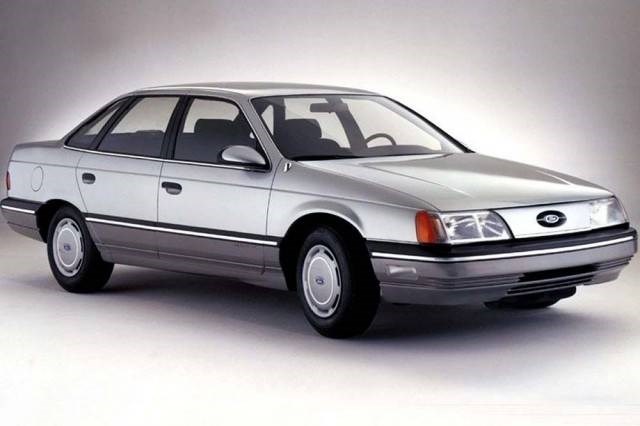The 1970s and early eighties were difficult times for the American automobile industry as it struggled to meet tightening fuel economy legislation brought on by two 1970s oil crises, and to comply with increasingly stringent emissions standards. On top of that was intensifying foreign competition, particularly from the apparently invincible Japanese.
The troubled times brought Chrysler to its knees, fortunately rescued by government loan guarantees negotiated by its new chairman Lee Iacocca. Ford also experienced financial problems and in 1980 General Motors incurred its first full year loss since the 1921 post-First World War recession.
While Chrysler was recovering and GM reorganizing, Ford changed the guard in 1979 by appointing career Ford executive Philip Caldwell as chairman and CEO. He took over from retiring Henry Ford II, becoming the first non-direct descendent of founder Henry Ford to hold the top post in the company’s 76 year history.
It proved to be a seminal event for a more optimistic 1980s. Under chairman Caldwell and new president Donald Peterson, Ford gave chief stylist Jack Telnack free rein to replace its square, stodgy cars. He set Ford on the path to modern aerodynamic forms that culminated in the all-new 1986 Ford Taurus and corporate twin Mercury Sable.
Both Caldwell and Peterson had European experience where slippery wind-cheating cars like Citroen and Audi demonstrated the benefits of aerodynamic efficiency. Ford’s first aero foray was the 1983 Ford Thunderbird and twin Mercury Cougar, and the new compact Ford Tempo/Mercury Topaz.
But these were the preliminary steps to the breakthrough that arrived on Dec. 26, 1985: the all-new 1986 Ford Taurus.
In a glitzy presentation on Hollywood’s MGM sound stage where legendary movies like Gone With the Wind and Wizard of Oz were filmed, Ford revealed its $3-billion gamble.
It was an almost bet-the-farm decision for Ford to launch such a radical car into the very important but relatively conservative mid-size family sedan segment. In spite of any concerns, it turned out the public was ready for a departure from the staid, upright Ford LTD the Taurus replaced. The LTD suddenly looked square and old fashioned.
The Taurus came in sedan and wagon versions, and the organic, flowing Audi-like lines, flush glass and headlights and body-integrated bumpers gave a commendable coefficient of aerodynamic drag of 0.32 for the sedan, and 0.34 for the wagon. Its 2,692 mm (106 in.) wheelbase and 4,785 mm (188.4 in.) length were an ideal combination of space and manoeuvrability.
The Taurus and Sable were identical mechanically but with cues appropriate to Sable’s more conservative market target. Taurus’s grille area had only a small egg-shaped opening with Ford’s trademark blue oval badge floating in the middle, while the Sable received a full-width, glowing “light bar.”
The Sable’s more formal sedan had only two side windows, with the back window wrapping around a little. The Taurus had three side windows.
Power came from the newly designed transversely mounted 3.0 litre, overhead valve 140 horsepower “Vulcan” V-6 driving the front wheels through a four speed automatic transmission. A 2.5 litre pushrod four with five-speed manual or three-speed automatic would also be offered, mainly as a fleet special. It was not very popular and was discontinued in 1990.
Sedans had strut-type coil spring suspension all around, but the wagon had rear lateral links to eliminate the space-robbing strut towers in the cargo area. Steering was rack-and-pinion with a quick ratio of 2.6 turns lock-to-lock contributing to precise handling.
The Taurus’s performance was quite competitive. Car and Driver (4/86) was very enthusiastic about it, as were other motoring publications. They reported the V-6 accelerated the 1,475 kg (3,250 lb) sedan 60 mph (97 km/h) in 9.8 seconds and a top speed of 184 km/h (114 mph). Not tire burning, but competitive in its class.
For those seeking higher performance and sharper handling, the Taurus SHO arrived for 1989. Its Yamaha-built, 3.0 litre double overhead cam, 220 horsepower, 24-valve V-6 certainly made it faster. C and D (12/88)) called it “America’s Best Sedan,” and recorded zero to 60 mph (97 km/h) in 6.7 seconds and top speed of (143 mph (230 km/h).
But SHO sales fell below expectations, partly because it came with a manual transmission only. An automatic eventually became available, although it took five years.
The Ford Taurus was a brave venture for Ford that paid off handsomely. It became one of North America’s top selling mid-size family cars, and after a successful 20-year run that included several freshenings the last Taurus rolled off the assembly line in 2006.
But not for long. The name returned in 2008 on both a crossover (former Freestyle) and large sedan (former slow selling Five Hundred). It became the fully restyled Taurus sedan for 2010 and is still in Ford’s lineup.



